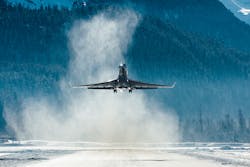Sensor Technology's One-Two Punch: Improving Winter Maintenance Operations and Meeting ICAO GRF Regulations
As we all know, even a little bit of inclement winter weather can have a significant impact on airport operations and traveler safety. Whether a massive international airport that sees thousands of arrivals and departures every day or a smaller airfield with just one runway, safety and efficiency of operations are the primary concerns for airports of all sizes.
From ice, snow and frost to standing water and the presence of chemicals on the runway, it’s crucial that airport decision-makers are equipped with the meteorological data and runway condition information they need to prepare for, respond to and ultimately mitigate the impact of winter weather.
With runway maintenance being a top priority during the snow and ice season and the International Civil Aviation Organization (ICAO) Global Reporting Format (GRF) regulation going into effect later this year, airport managers will soon be required to report conditions and contaminants on each third of the runway.
In order to effectively alleviate the impact of winter weather while simultaneously remaining in compliance with the upcoming GRF requirements, forward-thinking airports are turning to advanced sensor technology to monitor snow and ice, as well as assess and report runway conditions in real time.
Leveraging Sensors to Improve Winter Maintenance Operations
According to ICAO, inspectors can manually assess the runway surface state using their own senses to determine if it’s safe for a plane to land or take off. The presence of standing water, snow, ice or slush can make it difficult for planes to take off or land safely, however, manual observations face great challenges in making measurements consistent and comparable. Unfortunately, manual assessments, or friction measurements currently in use at many airports, can be far less representative of the actual surface state than leveraging sensor technology to measure specific runway conditions.
Assessing and measuring specific runway conditions is critical to airport safety because the impact of weather on runway, taxiway and apron area surface conditions cannot be directly derived from the atmospheric environment alone. For example, pavement surface temperatures can substantially vary from the temperature of the air, and the concentration of chemicals present on the runway can affect whether ice will begin to form on a runway surface. No matter how responsible and experienced an inspector might be, determining the runway surface temperature, the type and amount of contaminant and the concentration of chemicals present remains nearly impossible without sensor technology providing insight into changing conditions.
Employing advanced sensor technology — like runway sensors or mobile sensors on fleet vehicles surveying the runways — to develop an in-depth understanding of potentially deteriorating conditions empowers decision-makers with more representative, objective, consistent and accurate information than a manual assessment ever could. With more reliable data, airports can better manage winter maintenance operations, determining when and where to deploy maintenance teams, which snow and ice removal equipment and materials are necessary before and during a winter weather event and whether to temporarily close runways or completely cancel flights.
ICAO’s New GRF Requirements Add New Responsibilities
Increasing the level of challenge, the new ICAO GRF regulation will begin to be enforced on Nov. 4, placing new demands on airports, pilots and other personnel at all ICAO-registered international airports.
Adopting many practices from the Federal Aviation Association’s Takeoff and Landing Performance Assessment (TALPA) initiative, the new GRF enhances safety by expanding the TALPA framework into a universally consistent method of assessing and reporting runway conditions that impact aircraft performance when landing or taking off, thereby affecting safety.
Alongside obvious risks to passengers and crew, overruns and runway excursions — especially incidents resulting in hull loss and fatality — pose significant safety- and efficiency-related problems that can threaten airlines and airports with economical losses and damaged reputation. As a matter of fact, statistics from Airbus reveal that, between 1999 and 2019, runway overruns and excursions accounted for 36 percent of hull losses and 16 percent of fatal accidents. Recognizing the insufficiency of current mitigation strategies and technologies, the new GRF addresses these dangers by creating standardized assessment methods and runway condition reports, with two sections: aircraft performance calculation and situational awareness assessment.
The upcoming GRF includes the following changes:
- Reliance on observed contaminants rather than friction measurements on each runway third.
- Assessments must take place whenever there are significant changes to runway conditions, not just periodically.
- Reporting is mandatory around the globe, even in locales with no freezing weather, with the U.S. and Canada continuing to adhere to TALPA.
The aircraft performance calculation includes runway condition codes from 0, worst condition, unusable runways, to 6, best condition, clear and dry, for each runway third; contaminant coverage assessment; depth of contaminant layer(s); and generalized condition description, with 15 standardized choices. The situational awareness assessment involves the description of snowbanks, chemical treatments, runway length reductions, etc. and includes the option for free-form remarks.
In spite of these added responsibilities, new sensor technology can support compliance of the regulation and empower airports, pilots and other personnel with more meaningful data, improved awareness and better decision-making.
How Mobile Sensor Technology Helps with Compliance
When it comes to runway management, the ideal GRF-compliant solution deploys sensor technology and an integration platform for consolidating data, reporting and alerts.
This kind of solution makes it much more simple to convey actual runway condition information to pilots in terms that directly relate to expected aircraft performance. Using only manual methods of runway condition assessment can lead to inefficiencies in the assessment and reporting process. Moreover, as those assessments depend on individual inspectors evaluating the runway surface state, the consistency of the outcome may become suboptimal: The challenge with this manual approach is that people are different and, as such, can come to different conclusions regarding the same conditions. By enabling different inspectors to assess and report on runway conditions consistently, sensor technology also frees them to concentrate on other condition factors and accelerate the normal GRF workflow, increasing efficiency.
Advanced mobile sensor systems use real-time measurements of runway contaminant types and layer depths to improve assessments and create outputs that are aligned with GRF reporting standards. With high-precision laser technology, modern mobile sensors can assess contaminant types and layer depths with unmatched accuracy, creating representative data sets everywhere an inspector drives, not just in a few spots along the runway.
Plus, mobile sensor technology is exceedingly fast and can make reports available as soon as the assessment has concluded. By minimizing the amount of time inspectors have to spend conducting assessments on runways, sensors help improve airport capacity through shortened runway traffic disruptions, aid in maintaining normal operations and save staff resources. Even better, by minimizing impacts to aviation traffic flow, airports gain operational safety and improved efficiency as well.
Perhaps best of all, mobile sensor systems can be compact and extremely robust, which means they can be mounted on any fleet vehicle to measure virtually all reported contaminant types, including dry, wet, frost, ice, slush, standing water, etc. By leveraging real-time weather measurements on runway surfaces and employing software to process sensor data, modern sensor systems deliver accurate, reliable data that can be converted into the ICAO GRF-required text-based format that pilots and airport personnel can trust under all conditions.
While each airport’s preferred assessment methods and technologies will vary based on climate, funding and capacity considerations, most airports will soon need to adopt the shared language of GRF, making end-to-end sensor solutions more important than ever before. At the end of the day, airports want to stay open and stay safe. By employing advanced sensor technology solutions, airports are empowered with the immediate, accurate and reliable reporting on runway conditions necessary to not only improve winter maintenance operations but stay compliant with upcoming ICAO GRF regulations, gain efficiency and improve decision-making.
Mauri Vapola is a Solution Manager at Vaisala, with extensive experience in engineering, meteorology, and aviation. Today, he leads Vaisala’s runway condition reporting initiatives and is an expert on GRF and related matters.
About the Author

